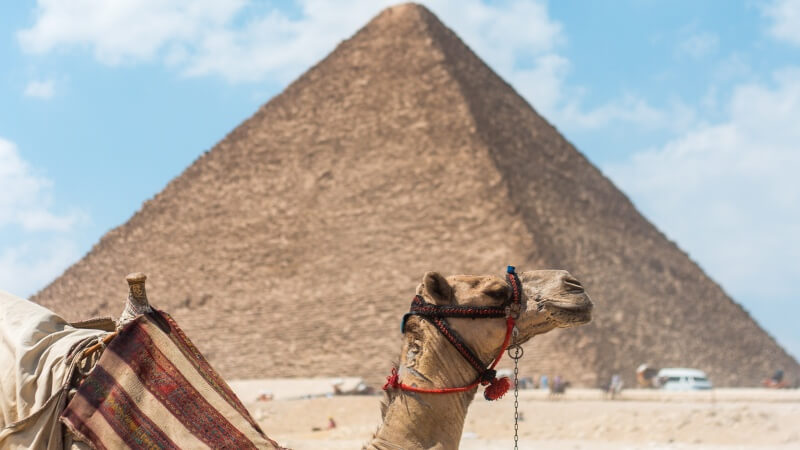
Gym Essentials For Women:A Complete List
Enthusiasts who never miss a session, understanding the gym essentials for women is crucial, not just for what to wear but also for what to

Planning your Egypt vacation? Think of the land of the Pharaohs, where the Sphinx, the Pyramids, and the Nile river create a timeless allure. Egypt, indeed, is the quintessential destination for anyone’s bucket list. It boasts the oldest man-made structure on our planet, making it unparalleled in historical significance! Crafting the ideal Egypt Itinerary is more than just the pyramids-it’s an immersive journey into much more!
Ignoring the political instability in a region that’s somewhat volatile, it’s hard to imagine someone who wouldn’t be captivated by the desire to visit the Egyptian pyramids. Really, who could resist the allure of standing beside these 5000-year-old stone marvels, shrouded in mystery about their construction and exact origins?
Ever since I was a child, long before I understood the concept of wanderlust, Egypt had captivated my imagination. My fascination with wanderlust started pretty early, and it’s as if I’ve always known about the pyramids – they’ve been a constant in my thoughts. From the earliest books I read, filled with tales of pyramids, pharaohs, and mummies, these were the things that shaped dreams (and sometimes nightmares… those mummies, yikes!) of my childhood.
Egypt was a highlight I eagerly anticipated during our family’s gap year. But by the time we reached the Middle East, eight months into our year-long adventure, I was feeling the weight of constant travel. Not even the stunning sight of Petra’s Treasury could fully lift my spirits.
But then, the pyramids?
Absolutely!
What a relief!
I had told myself that if I didn’t feel utterly awestruck standing beside the pyramids, I might as well pack up, go home, and take a break from traveling (maybe for a couple of months at least!).
While the pyramids are undoubtedly Egypt’s main attraction, remember, there’s so much more to this country than just Cairo. Dare to think beyond these ancient wonders!
This itinerary is flexible and definitely doable on your own. Traveling independently in Egypt is feasible, and with a bit of travel savvy, there’s no need for apprehension!
From my personal experience, Egypt felt very safe. Yes, there are persistent vendors, but they’re generally harmless. The locals were friendly and welcoming, and we never felt uneasy about our safety.
For more detailed insights, check out this blog post on safety in Egypt. It resonates with my thoughts, particularly regarding traveling with kids. If it’s safe for children, it should be safe for anyone!
The local currency is the Egyptian Pound, or LE, a remnant of the French colonization era. It’s divided into 100 piastres. You’ll find coins in 25p, 50p, and 1LE denominations, and banknotes are more common, ranging from 1LE to 200LE. Getting change wasn’t an issue, unlike our experiences in Burkina Faso. Having exact change is handy for bargaining in markets!
Credit card acceptance is growing but mostly in upscale places. During our 10-day stay, I used my card for some hotel payments and airport purchases. Cash reigns supreme, especially for budget or mid-range travelers.
*pro tip – Prices in accommodation are often in USD, and you might get a better rate paying in that currency. Have enough USD or Euros to cover your accommodation.
ATMs are plentiful in Cairo, Aswan, and Luxor, accepting Cirrus and Plus cards. Most ATMs have a 4-digit PIN requirement, so adjust yours accordingly before your trip.
ATM withdrawal limits are usually around 1000LE to 2000LE. To avoid high transaction fees, withdraw the maximum amount possible.
For safety, consider an anti-theft bag for carrying money and valuables. It’s not just about security; it also gives a sense of confidence, which might deter potential thieves.
SIM cards are affordable and widely available. Vodafone offered excellent coverage in all the places mentioned in this itinerary. I paid 134 LE for a 6GB data plan, which was sufficient thanks to wifi in accommodations.
Another option is Skyroam, a global wifi hotspot that works in over 130 countries. It’s pricier but can be more convenient for short stays or multiple-country visits.
Tap water in Egypt isn’t drinkable, so stick to bottled or filtered water. Many accommodations provide easy access to safe drinking water. To minimize plastic use, consider bringing a Grayl water filter system.
For more information, explore the best travel water reminder bottles. Don’t forget an insulated bottle – it’s crucial in Egypt’s heat to keep your water cool!
Generally, I’m not a fan of insurance, but I never travel without solid travel insurance. The stakes are just too high, and I’ve listened to too many tales of people suffering abroad without it. During our year of globetrotting, we chose WorldNomads.
Their rates were fair (especially for Canadians), and while I thankfully never needed to claim, I’ve heard positive feedback from others who did. For Americans, Allianz might offer more competitive rates. We haven’t used them ourselves, but our friends who are insured by Allianz rave about their experiences!
Alright, with the basics covered, let’s dive into the ITINERARY!!!
Kick off with a 5 day Egypt Itinerary, perfect for a quick but fulfilling tour. In these 5 days, you’ll experience Cairo and Luxor, immersing yourself in the most iconic sights and the marvels of ancient Egypt. Cairo, being the main international hub, is an ideal starting point for your 5 day Egypt journey.
DAY 1 – 2: CAIRO
Explore the pyramids, the Egyptian Museum, and the vibrant Khan El-Khalili market.
Opt for a stay in Giza for a spectacular night view of the pyramids or a pyramid-view coffee break in the morning.
DAY 3 – 5: LUXOR
Discover the majesty of Karnak, the Valley of the Kings, Luxor Temple, and the Luxor Museum. Experience a breathtaking hot air balloon ride over ancient Egyptian landmarks.
Choose accommodation on the West Bank of the Nile to escape the crowds yet stay close to key attractions.
With a week in Egypt, adding Aswan to your 7 day Egypt Itinerary enriches the experience. Aswan offers a chance to explore offbeat paths and lesser-known historical sites. Spend the first 2 days in Cairo, followed by 2 days in Aswan, and wrap up with 3 days in Luxor.
DAY 1 – 2: CAIRO
Revisit the pyramids, the Egyptian Museum, and Khan El-Khalili market as in the 5-day plan.
Stay in Giza to enjoy the illuminated pyramids at night or morning views over coffee.
DAY 3 – 4: ASWAN
Visit the underrated Philae and Kalabsha Temples and a day excursion to Abu Simbel.
Stay in a traditional Nubian guest house on the West Bank and mingle with locals on a Nile ferry.
DAY 5 – 7: LUXOR
Similar to the shorter itinerary, explore Karnak, the Valley of the Kings, and Luxor Temple. Don’t miss the hot air balloon adventure over the ancient sites.
Stay on the West Bank for a less touristy, more authentic Luxor experience.
For a 10 day Egypt journey, consider a relaxed Nile cruise from Aswan to Luxor. This option lets you soak in the Nile’s beauty during your trip, witnessing daily life along its banks. Start with 2 days in Cairo, then 2 days in Aswan, enjoy a 3-day Nile cruise, and conclude with 3 days in Luxor.
DAY 1 – 2: CAIRO
Visit Cairo’s highlights: the pyramids, Egyptian Museum, and Khan El-Khalili market.
Stay in Giza to witness the night-lit pyramids or enjoy a morning beverage with a pyramid view.
DAY 3 – 4: ASWAN
Explore lesser-known gems like Philae and Kalabsha Temples and take a trip to Abu Simbel.
Opt for a Nubian guest house on the West Bank, experiencing the local way of life.
DAY 5 – 7: NILE CRUISE
Choose a felucca or a luxury cruise for a memorable Nile journey, an Egypt trip highlight.
DAY 8 – 10: LUXOR
Follow the 5-day plan in Luxor, visiting Karnak, the Valley of the Kings, and more. A hot air balloon ride is a must for stunning aerial views.
Stay on the quieter West Bank, yet within easy reach of Luxor’s wonders.
Cairo serves as the prime kick-off point for any Egypt journey, mainly because it’s where most international flights land. While I’m allotting just 2 days to Cairo (it’s a bustling, somewhat chaotic city that didn’t quite win my heart!), don’t feel compelled to follow suit. Cairo is brimming with activities, yet I believe 2 days are sufficient to cover the highlights and then escape its hustle (just my two cents)!
The crown jewel of Cairo is undoubtedly the Great Pyramids of Giza. I’ve penned a detailed post on visiting the pyramids (which you can check out here!), but for the sake of brevity, here are the key points!
Given the security situation in neighboring countries, it’s unlikely you’ll enter Egypt via land. Most travelers arrive by air, landing at Cairo airport. Getting to the city center is a breeze with taxis, buses, and Uber – yes, Uber works great in Cairo. Many hotels offer airport pickup services for a fee, which I often choose for the convenience post-flight.
Upon arrival in Cairo, grab your $25 USD visa stamp at one of the airport kiosks before heading to immigration. A word of caution: the customs line can be chaotic. Be assertive and prepared to politely fend off line-cutters!
Missing the pyramids on a Cairo visit is unthinkable. Allocate at least half a day, though I recommend a full day for a thorough exploration. It’s a long journey to Egypt, and you’d want to relish the experience at the pyramids.
*pro tip – Cairo heats up quickly, so start your day early to dodge the crowds and the midday sun.
The pyramid site encompasses the three main pyramids, the Sphinx, Khufu’s boat, and several smaller Queen’s pyramids. Wander through all these sites, but spend a bit more time at the less crowded smaller pyramids.
If you’re not claustrophobic, venture inside at least one pyramid. They’re similar, but each has unique aspects. My favorite was the smallest (Menkaure) for its lesser crowds and fascinating wall details. And don’t miss out on a camel ride around the pyramids – best done from Menkaure’s pyramid for that iconic photo!
Walking between the pyramids is doable, but you can also hire a camel, horse & carriage, or a van and driver for the day. Another option is joining a day tour, combining transport and guide services.
To cap off your pyramid experience, attend the evening Light and Sound show. Alternatively, if you’re staying in Giza (which I suggest), watch the show from your accommodation’s rooftop. Order some takeout, settle in comfortably, and enjoy the illuminated pyramids from afar, minus the crowds!
Hours: 08:00–17:00
Cost: From 60LE (approx. $4.60 CAD)
– External Visit: 60LE ($4.60 CAD) adult / 30LE ($2.30 CAD) student
– Internal Visit: 100LE ($7.70 CAD) adult / 50LE ($3.85 CAD) student
The Pyramids may be Cairo’s star attraction, but the city has much more to offer! On our visit, we regretfully breezed through Cairo, lingering longer in Luxor. Luxor’s charm is undeniable, yet I now realize a second day in Cairo, especially at the Egyptian Museum, would have been worthwhile. While Tutankhamun’s tomb in Luxor is impressive, the bulk of his burial treasures reside in Cairo’s Egyptian Museum.
From Giza, where most stay near the pyramids, it’s about an hour’s drive to the museum – a perfect reason to kick off day two early! The museum is vast, and though you could spend days perusing, a morning visit fits into a tight two-day Cairo itinerary. This allows time to cover the main exhibits, particularly Tutankhamun’s treasures. Check if these artifacts are on display during your visit, as they occasionally tour. Beyond the Boy-King’s treasures, there’s a plethora of other historical wonders to explore.
*pro tip – Enhance your museum visit with a knowledgeable guide!
Post-museum, hop on an Uber for a short 15-minute ride to Cairo’s central souk, Khan El-Khalili. Refuel with a range of dining options, including tempting street food, before diving into the Souk’s vibrant atmosphere.
First-timers to a Middle Eastern Souk should be ready for an intense experience. Vendors are assertive, and bargaining is part of the game. The Souk offers everything from authentic artisan crafts to touristy knick-knacks and antiques. It’s an ideal spot for souvenir hunting, but be selective and negotiate fiercely. The Souk’s expanse warrants a few hours to wander its labyrinth of lanes.
*pro tip – Download an offline Google map of Cairo for easy navigation in the Souk. To do this: open Cairo’s map on your phone, type “ok maps” in the search bar, hit “search”. Adjust the area you want to download, then select “download”. This map will be available offline, guiding you through the Souk’s maze and back.
Our Cairo stay was at a superb AirBnB, boasting a rooftop view of the pyramids, which I wholeheartedly recommend. It’s a cozy 3-bedroom apartment, and the owner, Walid, is exceptionally hospitable. Walid, along with his brother, provided airport pickup and served as our guides at the Pyramids.
He skillfully negotiated for souvenirs, ensuring we paid just a fraction of the original price. Walid’s philosophy is to make guests fall in love with Egypt, not feel exploited, hoping they’ll return and spread the word.
The Koshary comes highly recommended.
Cost: Approximately 35LE for a medium bowl of Koshary.
Uber is the most convenient transportation mode in Cairo. Affordable and user-friendly, it’s a practical choice. Ensure you have an Egyptian SIM card (readily available at the airport) for hassle-free ride tracking. However, be prepared for Cairo’s speedy driving style. On our airport-bound Uber ride, I noticed our ETA rapidly decreasing due to our swift pace. Remember, it’s okay to ask your driver to slow down if you’re uneasy!
Cost: Roughly 100LE for an Uber ride from Giza to Cairo airport.
If you have only 5 days in Egypt, head straight to luxor
With just a 5-day Egypt itinerary, prioritize Luxor and save Aswan and the Nile for another adventure!
Following your exhilarating two days in Cairo, with the Pyramids and the Cairo museum under your belt, it’s time to head South to Aswan. This city was a crucial gateway to Ancient Egypt, largely due to its proximity to stone quarries that supplied materials for the pyramids and temples.
*pro tip – Aswan’s temples and ruins, though remarkable, don’t have the vibrant preservation of the Valley of the Kings. I suggest visiting Aswan before Luxor to maintain a sense of wonder and awe. Luxor first might lessen Aswan’s impact.
In Aswan, you’ll actually spend one day exploring the city and another day at Abu Simbel. While Aswan deserves more than a day, a tight schedule can make it workable.
Sleeper Train – $100 US per adult in a double cabin, includes dinner and breakfast. $90 US for children aged 4-9, free for those under 3.
Flight – Egypt Air runs 3 daily non-stop flights from Cairo to Aswan, taking around 1 hour and 25 minutes. Prices range from $100-150 CAD one-way, varying by booking time and flight choice. Both airports are user-friendly and the flight option saves time compared to the 12-hour train ride.
Cost: $100-150 CAD one-way
Bus – The bus is the most budget-friendly option but also the longest and least predictable. Though I haven’t experienced it myself, research is key if opting for the bus. I found Alternative Egypt to be a helpful resource.
Cost: around 47LE ($3.60 CAD)
Philae Temple, accessible only by boat, is an essential part of any Aswan visit. Originally on Philae Island, said to be Osiris’s resting place, the temple faced submersion due to the Aswan High Dam’s construction in 1960. UNESCO intervened, moving the temple to its current location. While some color was lost to flooding, many impressive hieroglyphics remain.
To visit Philae Temple, take a water taxi from Marina Philae Temple. If traveling independently, be ready to haggle for the boat taxi after purchasing your temple ticket. Alternatively, a guided tour can simplify the process.
Hours: Oct-May 7am-4pm, June-Sept 7am-5pm
Cost: 60LE ($4.60 CAD) for a full day, including the evening light show. Boat trip: around 40LE ($3 CAD) per person, return.
*expert tip – Our Aswan activities were seamlessly arranged by Waleed from Aswan Individual. He provided airport transfers, organized our day trips, including Philae Temple and Abu Simbel, and managed our Felucca journey to Luxor. His service was exceptional – prompt and professional. Highly recommended for anyone visiting Aswan or Egypt. (This isn’t a sponsored mention; we paid full price. Waleed’s exceptional service warrants this recommendation.)
Constructed between 1960 and 1970, the Aswan High Dam was a massive project to control the Nile’s flow. Spanning 4000m (13,000ft) in length and 980m (3220ft) wide at its base, it’s an engineering marvel. While tours of the Dam are available, they’re perhaps best suited for those with a keen interest in dam engineering. I suggest a brief stop to admire the views, particularly towards Lake Nassar, which is quite breathtaking.
The dam has had mixed impacts on Egypt’s environment and economy. One interesting outcome, especially for the kids, was the almost complete absence of Nile crocodiles downstream of the dam. Only smaller crocodiles can navigate the turbines, while larger ones are often fatally injured. This has made swimming in the Nile far safer and more enjoyable!
Cost: 30LE ($2.30 CAD) to cross the dam (free for kids under 5).
Kalabsha was the highlight of my Egyptian temple visits, not so much for the temple itself but for the peaceful, tourist-free experience. Located on a small island just south of the Aswan High Dam, access requires hiring a local fisherman for a boat ride. The solitude was profound; we were the only visitors, and the ticket collector even returned with us, not expecting more visitors that day!
Kalabsha, though smaller than Philae’s main temple, is equally majestic. You can meander through the rooms and courtyard at your leisure, taking time to interpret the hieroglyphics and appreciate the details without the rush of crowds.
A short walk away is Beit El-Wali, erected by Ramses II between 1279 and 1213 BC. Buried under sand for millennia, this small temple’s inner and outer rooms retain vividly colored wall drawings. These ancient, colorful depictions are a rare sight in Egypt and are particularly striking considering their age.
Hours: No specific hours are posted, but the site seemed to close by mid-afternoon. We left around 3:30pm and the guard accompanied us, so plan to arrive by early afternoon at the latest.
Cost: 40LE ($3 CAD) for entry (free for kids under 5). Independent travelers should budget 100-150LE ($7.70-11.50 CAD) for a round-trip boat ride, including wait time.
The twin temples of Abu Simbel, requiring the most effort to visit among Egypt’s famed structures, are absolutely worth it. Constructed by Ramses II for himself and his wife Nefartari, these monumental temples were carved out of a mountainside and later relocated to avoid submersion due to the Aswan High Dam. Their beauty and the story of their preservation are nothing short of an engineering wonder.
Flight – Egypt Air offers up to 4 daily flights from Aswan to Abu Simbel. The last return flight typically leaves around 1:10 pm, requiring an early morning start for sufficient temple exploration time. Flights can be pricey and don’t save much time compared to a private van.
Cost: $200-300 CAD round trip
Minibus – The most budget-friendly option, though somewhat restrictive. Booking through your guesthouse is easiest, with early morning departures (around 4:30 am) and about 2 hours at the temples. These buses are known for their speedy driving, which might be uncomfortable for some.
Cost: $15-20 US per person round trip
Private Van – Ideal for groups, as was our case with 7 people. We departed at 5:30 am, allowing for more temple time and a safer, slower drive.
Cost: $120 US round trip, including hotel pickup and drop-off
Day Tour – Booking a guided day tour is the simplest option. Like the minibus, you can book through your guesthouse or in advance for peace of mind.
The twin temples, completed around 1244 BC, showcase Ramses II’s grandeur and his dedication to queen Nefertari. The UNESCO-led relocation of these temples in 1968 to avoid submersion is a remarkable tale of engineering.
The Great Temple of Ramses II, with its four giant statues, is an awe-inspiring start to the visit. The walkway leading up to it offers the iconic Abu Simbel photo opportunity.
Nefertari’s temple, though smaller, is equally majestic, with statues of both Ramses II and Nefertari flanking its entrance. Inside, the focus shifts to Nefertari and the goddess Hathor.
For a unique experience, consider staying overnight to catch the Light Show at sunset. The show’s commentary language varies, so it may not always be in English.
Abu Simbel can get crowded, especially from 8-11 am. To avoid the busiest times, aim to visit between 7-8 am or after 11 am.
Hours: 5am – 6pm, light show at 6pm in winter and 7pm in summer
Cost: 215 LE ($16.80 CAD) per adult, half price for kids and students. Light show: 250 LE ($19.60 CAD) for adults, half price for kids and students.
Our choice in Aswan was the Bet El Kerem Guesthouse, ideally situated on the Nile’s West Bank. They offer family rooms and affordable doubles with shared bathrooms. The stay included a sumptuous homemade breakfast on their rooftop terrace, which boasts a stunning view of the Nile and the Temple of the Nobles. There were always refreshments available on the terrace, and their excellent chef could whip up other meals for a small charge.
Laundry service was also a plus! Being on the West Bank, we had to use the ferry to access Aswan’s main attractions, adding a unique charm to our stay. The only downside was the tourist price for the ferry – 10LE ($0.75CAD) per person each way, while locals paid only 1-2LE. However, the guesthouse was conveniently close to the ferry stop.
Check out the latest pricing for Bet El Kerem Guesthouse.
Explore other great hotel options in Aswan:
Getting around aswan
Taxis are the go-to mode of transportation in Aswan, as Uber wasn’t available during our visit. The city center is compact enough for walking, but many key sites like the Philae Temple and Aswan High Dam are a few kilometers away. For these reasons, it’s practical to either hire a taxi or opt for a day tour.
With only 7 days in Egypt, head next to Luxor and plan the Nile cruise for a future trip!
Navigating the Nile offers two distinct experiences: a luxury cruise or a traditional felucca. The choice boils down to your travel preferences and, interestingly, the wind conditions.
As adventurous travelers, we naturally gravitated towards the felucca, drawn by its affordability and thrill. However, our journey hit a snag with the complete absence of wind, rendering our felucca immobile and leading to an uneventful couple of days drifting near Aswan (you can find the full story of our felucca misadventure here!). In retrospect, a cruise would have ensured progress from Aswan to Luxor, unlike our static felucca experience.
Since we didn’t complete a Nile cruise ourselves, I reached out to Keri for insights. These cruises operate in both directions (Aswan to Luxor and vice versa), so their experience from Luxor to Aswan mirrors what you’d encounter on the reverse route. Though marketed as 5 days/4 nights, these often include time exploring Aswan and Luxor. For more independent exploration, consider a shorter 3 day/2 night cruise.
Find the best Nile Cruise for you!
A Nile Cruise combines the luxury of a comfortable, air-conditioned room with the ability to cover significant ground. Our 5-star Luxor to Aswan cruise, though billed as 5 days/4 nights, entailed about 1.5 days of actual cruising. The cruise served as a base for sleep and meals, with numerous organized day excursions.
Docking in Luxor the first night allowed a full day to explore Karnak and Luxor Temples, plus a morning at the Valley of the Kings and Hatshepsut Temple. Post-lunch on the second day, we sailed south through the Esna lock, docking at Edfu overnight.
An early start on the third day took us to Edfu Temple via horse-drawn cart, followed by cruising to the Temple of Kom Ombo and overnight docking in Aswan. In Aswan, we explored the High Dam, Philae Temple, and enjoyed a felucca ride around Elephantine Island before spending our final night on board.
For extended stays in Aswan or Luxor, transitioning to a hotel is an option, with return to Cairo by flight or train.
Be mindful that the cruise often involves docking alongside multiple ships, limiting your cabin view to neighboring vessels. Despite this, the convenience of a single unpacking and not worrying about meals was appreciated. The buffet catered well to various tastes.
We had cabins on both sides of the ship, allowing us to enjoy different views. A top tip: West-facing cabins offer superior vistas. The moments we did cruise, relaxing on the sun deck and witnessing the sunset to the backdrop of calls to prayer, were amongst our most cherished Egyptian experiences.
Luxor, the ancient city of Thebes and once the city of God Amun, served as the capital of Upper Egypt for many dynasties until the power shifted to Alexandria. Despite this, thanks to Karnak Temple, Luxor remained a spiritual heartland of Ancient Egypt until it fell to the Roman Empire. The city is often likened to an open-air museum because of the sheer volume of ancient relics and temples dotting the landscape, where old and new coexist in relative harmony.
How to get from cairo to luxor
You have several options to travel from Cairo to Luxor, ranging from flights and boats to trains and buses. If time is tight, flying is the best bet.
Airplane – The journey from Cairo to Luxor by air takes about an hour and is straightforward. EgyptAir offers safe and reliable services, with modern and efficient airports. Advance bookings often result in fares below $100 CAD, comparably priced to the night train but significantly faster and more convenient.
Cost: Approximately $100 CAD one-way with early booking.
Train – The 9-hour train journey offers day and night options. Booking the day train online is possible, and at around 200LE per seat, it’s much cheaper than the night train. It consumes an entire day but offers scenic views of the countryside. The night train, popular among tourists, combines transportation and accommodation but may not guarantee a good night’s sleep.
Cost: 200LE (day train), variable (night train).
Airplane – Flying from Aswan to Luxor usually involves a layover in Cairo, making it as lengthy as bus or train options, hence not recommended.
Train – The train ride from Aswan to Luxor takes 3-4 hours, depending on the train. There’s no sleeper train for this short distance, but A/C cabins ensure a comfortable journey.
Cost: 94 LE (A/C first class), 63 LE (A/C second class), discounts for children.
Taxi/Van – Tourist guidelines discourage driving on the Aswan-Luxor road after 6pm. If driving, leave early enough to complete the 4-hour trip before dusk. Despite our late departure at 6pm due to the felucca’s wind issues, we encountered no problems, though it seems we were fortunate. Morning departures are advised, with stops at Edfu and Kom Ombo en route.
Cost: From $100 USD, varies based on vehicle and stops.
Luxor Temple, in the city’s heart, epitomizes the “open-air museum” feel. Buried under sand post-Ancient Egypt, it was rediscovered and excavated, revealing its magnificence.
The colossal Ramsees II statue and the lone obelisk are striking. The obelisk’s twin resides in Paris, a gift from Egypt to France, highlighting past attitudes towards artifact relocation.
Connecting Luxor and Karnak Temples is the Avenue of the Sphinxes, still under excavation. After visiting Luxor Temple, take a moment to walk along the excavated path.
*pro tip – To avoid the crowds, visit earlier in the day as tour groups usually arrive in the afternoon and for sunset.
Hours: Oct-April 6am-9pm, May-Sept 6am-10pm, Ramadan 6am-6:30pm & 8-11pm.
Cost: 35LE ($2.70 CAD) adults, half-price for students under 30.
Exploring a vibrant market is always a highlight for me, and El Souk in Luxor fits the bill perfectly! Nestled in Luxor’s central pedestrian-only area, El Souk brims with a diverse range of items. It’s an ideal spot for picking up last-minute souvenirs or just soaking up the atmosphere of a Middle Eastern market. Over time, it has transitioned more towards catering to tourists rather than locals, but it’s still a worthwhile visit. For a more local market experience, head to the new location east of the Railway Station.
El Souk is accessible from several points, but the easiest entry is off the main roundabout near McDonald’s. Look for Abd El-Hameed Taha Street on Google Maps, marked by a large “El Souk” sign.
Hours: From dawn until dusk
Cost: Free entry! But remember, haggling is key here as tourists often face higher initial prices.
Karnak Temple, the pinnacle of religious significance in Ancient Egypt, is what sustained Thebes’ influence even after the capital moved to Alexandria. It’s the second-largest ancient religious site in the world, after Cambodia’s Angkor Wat.
The highlight for us at Karnak was the Great Hypostyle Hall and the Obelisks. The twin obelisks, commissioned by the female Pharaoh Hatshepsut, were once the tallest in the world. Today, only one stands, its companion long fallen.
*pro tip – Karnak’s size and complexity make it challenging to grasp without guidance. I highly recommend getting a guide for your visit.
Hours: May-Sept 6am-6pm, Oct-April 6am-5pm.
Cost: 150LE ($11.50 CAD) adults, 75LE ($6.75 CAD) students under 30, free for children under 5.
While the Luxor Museum doesn’t rival the vast Egyptian Museum in Cairo in size, it offers a serene and worthwhile experience. Dedicate an hour or two to this museum when in Luxor. Its smaller scale means fewer visitors, allowing for a more intimate exploration.
During our visit, we often found ourselves alone in the exhibit rooms, which was perfect for leisurely viewing and snapping a few discreet photos (though some areas prohibit photography, despite the camera fee I paid).
The museum’s highlights include two well-preserved mummies, along with an array of sarcophagi, coffins, and organ vessels. Everything is clearly labeled in English, enhancing the educational value of the visit. An added bonus, especially after a hot morning outdoors, is the museum’s air conditioning, offering a cool respite.
Hours: Oct-April 9am-3pm & 4pm-9pm, May-Sept 9am-1pm & 5-10pm.
Cost: 140LE ($10.80 CAD) adults, 70LE ($5.40 CAD) students under 30, free for kids under 5, 50LE ($3.85 CAD) camera fee.
A sunrise hot air balloon ride over the Valley of the Kings is one of Luxor’s most enchanting experiences. Despite the number of balloons and operators, prices remain steep due to high demand, but the experience justifies the cost.
An early start is required, with pick-up arranged by the balloon company. They’ll collect you from your West Bank accommodation or the East Bank ferry. East Bank hotel stays include transportation to the river crossing.
Floating above the temples as the sun rises is like entering a dream. This unforgettable experience is a must-do in Luxor.
*pro tip – Be aware that hot air balloons can be quite loud. If you’re sensitive to noise, consider bringing earplugs.
The Temple of Hatshepsut held high expectations for me, but admittedly, it wasn’t as striking as anticipated. Nonetheless, its historical significance as the first temple in the “New Kingdom” architectural style and its connection to Egypt’s first female Pharaoh, Hatshepsut, make it a must-visit.
The approach to the temple offers an impressive view of its entire facade, and the statues of Hatshepsut that line the front are particularly noteworthy.
Hours: 9am – 5pm
Cost: 140LE ($10.75 CAD) per adult, 40LE ($3 CAD) per child.
The Valley of the Kings is a vast necropolis deserving at least a full day’s exploration. While you could potentially spend several days here, the sites might begin to blend together after a while. A day should suffice to cover what your ticket includes.
Of the 63 tombs in the valley, your ticket grants access to three. For an additional fee, you can visit the more renowned tombs like Tutankhamun, Ramses V/VI, and Seti I. Tutankhamun’s tomb is highly recommended, with the others depending on your time and budget.
For the other tombs, consider visiting Ramses IV, Tutmosis III, Horemheb, and Seti II, as suggested by one of our guides.
*pro tip – The valley gets crowded with tour groups in the morning. Visit Hatshepsut’s Temple before lunch and save the Valley of the Kings for the afternoon. Tutankhamun’s tomb is best visited at the end of the day.
Hours: Summer 6am-5pm, winter 6am-4pm (Tutankhamun’s tomb closes from 1-2pm)
Cost: 200LE per adult, additional for special tombs: Tutankhamun 250LE, Ramses V/VI 100LE, Seti I 1000LE. Students under 30 get 50% off, and children under 5 are free.
For those still seeking more of Ancient Egypt’s rich burial history, the West Bank offers a trove of additional archaeological sites. The Tombs of the Nobles and the Valley of the Queens, along with several smaller temples, are well worth exploring.
Tickets for the Valley of the Queens can be purchased on-site, but for the other attractions, you’ll need to visit the ticket office near the Nourh El Gourna Hotel. If in doubt, your taxi driver should be familiar with the location and can guide you there.
Choosing between the East Bank and West Bank for accommodation is a common dilemma in Luxor. The East Bank is the hub for most tourist hotels, close to Karnak Temple and Luxor Temple, with an abundance of restaurants and shops. However, expect tourist-level prices here.
On the other hand, the West Bank offers a more subdued experience with smaller guesthouses and apartment-style hotels. It’s generally quieter with more affordable dining options due to fewer tourists. Plus, it’s closer to the Valley of the Kings.
Marsam Restaurant
Located near the Valley of the Kings on the West Bank, Marsam Restaurant is a favorite among archaeologists and Egyptologists. It’s set in a shaded courtyard, offering a tranquil dining atmosphere. The food is excellent and has been a popular choice for years.
Cost: A meal typically costs between 100-150LE ($7.70 – $11.50 CAD) per person.
Walking – the East Bank’s attractions are reasonably close and can be explored on foot.
Horse & Carriage – A staple of the East Bank, horse-drawn carriages offer a charming way to travel. For about 150LE ($11.50 CAD), depending on the journey length, it’s both a mode of transport and a unique experience. Drivers often double as impromptu tour guides.
Taxi – For longer distances, taxis are an affordable and convenient option, readily available across the city.
West Bank – The attractions on the West Bank are spread out, necessitating a day tour, taxi, or a bike for independent exploration. Taxis are easy to find and reasonably priced. Consider hiring a taxi for the whole day for efficiency and flexibility.
Ferry – A ferry connects the East and West Banks, operating continuously throughout the day. The fare is 2LE ($0.15 CAD) each way, with minimal wait times and a quick journey across.
Come experience the wonders of an Egypt vacation, where ancient history and modern charm await your discovery!


Enthusiasts who never miss a session, understanding the gym essentials for women is crucial, not just for what to wear but also for what to

A common myth circulating in the fitness world is the belief that a gym diet plan is unnecessary. Many seem convinced that they can simply

The average bench press, often referred to humorously in gyms as ‘How much ya bench’ or ‘whaddaya bench?’, stands as a quintessential measure of strength

Nowadays, we always seem to be packing a bag for something. Whether it’s getting ready for work with your messenger bag or briefcase, filling up

Enthusiasts who never miss a session, understanding the gym essentials for women is crucial, not just for what to wear but also for what to

A common myth circulating in the fitness world is the belief that a gym diet plan is unnecessary. Many seem convinced that they can simply

The average bench press, often referred to humorously in gyms as ‘How much ya bench’ or ‘whaddaya bench?’, stands as a quintessential measure of strength

Nowadays, we always seem to be packing a bag for something. Whether it’s getting ready for work with your messenger bag or briefcase, filling up
Copyright © 2025 remindsmartbottles. All Rights Reserved.
Copy the coupon code below and fill it in when you purchase to enjoy!
newuser